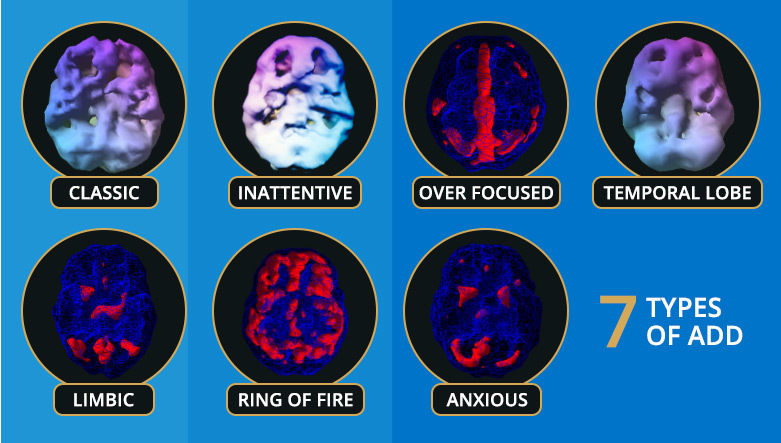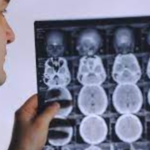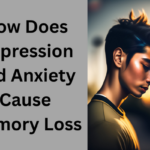Understanding the 7 Types of ADHD: A Comprehensive Guide
7 types of ADHD: Understand the variations, symptoms, diagnosis, and treatment. Get insights into living with ADHD and debunk myths. Expert-referenced guide.

Introduction
Welcome to our comprehensive guide on the “7 Types of ADHD.” Attention Deficit Hyperactivity Disorder, or ADHD, is a neurodevelopmental disorder that affects millions of people worldwide. It’s a condition that impacts various aspects of life, from school and work performance to personal relationships and overall well-being. In this article, we will delve into the world of ADHD, exploring its different types and shedding light on the unique challenges and strengths associated with each.
Understanding the Basics of ADHD
ADHD is not a one-size-fits-all condition. While some may envision ADHD as a single entity characterized by restlessness and impulsivity, it’s a far more complex spectrum of disorders. It’s crucial to recognize that ADHD presents itself in various forms, and understanding these distinctions can lead to more effective diagnosis and treatment.
Why Does Understanding ADHD Matter?
Before we dive into the specifics of the 7 types of ADHD, let’s discuss why understanding this condition is so essential.
- Accurate Diagnosis: Recognizing the specific type of ADHD a person has is critical for healthcare professionals. It allows for a tailored treatment plan that addresses individual needs.
- Improved Treatment: Different types of ADHD may respond differently to treatment methods. Understanding the type helps healthcare providers choose the most suitable approach.
- Empowerment: For individuals and families, knowing more about ADHD types empowers them to seek appropriate help, support, and strategies to thrive.
Now, let’s embark on a journey through the seven distinct types of ADHD, uncovering their characteristics, diagnosis criteria, and available treatment options. Whether you or someone you know is affected by ADHD, this guide will provide valuable insights into this complex condition, offering hope and guidance along the way. So, let’s begin our exploration of the fascinating world of ADHD.
What is ADHD?
Attention Deficit Hyperactivity Disorder, commonly known as ADHD, is a neurodevelopmental disorder that affects both children and adults. It’s characterized by a persistent pattern of inattention, hyperactivity, and impulsivity that can interfere with daily functioning and quality of life.
ADHD Defined: ADHD is a complex condition, and it manifests differently in each individual. However, there are three core symptoms that define the disorder:
- Inattention: People with ADHD often struggle with sustained attention to tasks, making careless mistakes, and organizing their activities. They may find it challenging to stay focused on tasks that don’t interest them and frequently lose important items.
- Hyperactivity: Hyperactivity refers to excessive restlessness and an inability to sit still. This symptom is most noticeable in children with ADHD, but it can also manifest in adults as an inner sense of restlessness.
- Impulsivity: Impulsivity involves acting without thinking through the consequences. Individuals with ADHD may interrupt others, blurt out answers in class, or have difficulty waiting their turn in a conversation or activity.
Prevalence and Impact: ADHD is one of the most commonly diagnosed neurodevelopmental disorders. Its prevalence varies, but on average, it affects about 5-10% of children and 2-5% of adults worldwide. Boys are more likely to be diagnosed with ADHD than girls, though this may be due to differences in how symptoms manifest.
The impact of ADHD can be significant. It can affect not only academic and occupational performance but also relationships and self-esteem. Individuals with ADHD may struggle with social interactions, organization, time management, and emotional regulation.
Historical Context: The understanding and diagnosis of ADHD have evolved over time. In the past, ADHD was often misunderstood, and individuals with the condition were stigmatized or mislabeled as lazy or undisciplined. However, research in the late 20th century led to a more accurate understanding of ADHD as a neurological condition with a genetic component.
ADHD has been categorized into various types, primarily based on the predominant symptoms exhibited by individuals. These categories help healthcare professionals provide tailored treatments and support.
In this comprehensive guide, we will delve deeper into the seven types of ADHD, each with its unique characteristics and challenges. Understanding these types is crucial for accurate diagnosis and effective management. So, let’s explore each type in detail and empower individuals and families dealing with ADHD to lead fulfilling lives.
Common Symptoms of ADHD
ADHD, or Attention Deficit Hyperactivity Disorder, is a neurodevelopmental condition that affects millions of people worldwide. While there are seven different types of ADHD, there are some common symptoms that can be found across all of them. Understanding these general symptoms is a crucial first step in recognizing ADHD in individuals and seeking appropriate help and treatment.
1. Inattentiveness: One of the hallmark symptoms of ADHD is inattentiveness. People with ADHD often have difficulty focusing on tasks, following through on instructions, and paying attention to details. They may become easily distracted, forgetful, and frequently make careless mistakes in school or work.
2. Impulsivity: Impulsivity is another key characteristic of ADHD. Individuals with ADHD may act without thinking, blurting out answers in class or interrupting others during conversations. This impulsivity can lead to social difficulties and impede their ability to regulate their emotions.
3. Hyperactivity: While hyperactivity is most associated with the hyperactive-impulsive presentation of ADHD (ADHD-HI), it’s important to note that some level of restlessness and hyperactivity can be present in all types of ADHD. Children with ADHD may have trouble sitting still, constantly fidgeting, or being “on the go” as if driven by a motor.
4. Difficulty with Organization: Organizational challenges are common in people with ADHD. They may struggle to keep their living space tidy, manage their time effectively, and plan tasks. These difficulties can lead to missed appointments, late assignments, and increased stress.
5. Poor Time Management: Time management can be a significant issue for individuals with ADHD. They often underestimate how long tasks will take, leading to a sense of being rushed or constantly running late. This can create stress and affect their ability to meet deadlines.
6. Forgetfulness: Forgetfulness is a common frustration for people with ADHD. They may frequently misplace items like keys or glasses, forget important dates and appointments, and have trouble remembering to complete tasks or chores.
7. Emotional Dysregulation: Many individuals with ADHD struggle with emotional regulation. They may experience mood swings, outbursts of anger or frustration, and difficulty controlling their reactions to everyday stressors. This emotional volatility can affect their relationships and overall well-being.
It’s important to note that while these symptoms are common in ADHD, their severity and combination can vary widely among individuals. Additionally, these symptoms may manifest differently depending on the specific type of ADHD an individual has.
Understanding these common symptoms is the first step in identifying potential ADHD in yourself or others. If you or someone you know exhibits these signs to a degree that it significantly impairs daily life, it’s advisable to seek a professional evaluation for a proper diagnosis.
Once diagnosed, appropriate treatment and support can greatly improve the quality of life for individuals with ADHD. In the following sections, we’ll delve deeper into the seven specific types of ADHD and explore how they manifest and are managed.
The 7 Types of ADHD

Attention Deficit Hyperactivity Disorder (ADHD) is not a one-size-fits-all condition. It manifests in various ways, and understanding the different types of ADHD is crucial for accurate diagnosis and effective treatment. In this section, we’ll delve into each of the seven distinct presentations of ADHD, shedding light on their unique characteristics, diagnostic criteria, and available treatment options.
1. Predominantly Inattentive Presentation (ADHD-PI)
Characteristics and Behaviors: ADHD-PI, often referred to as “inattentive type,” is primarily characterized by difficulties in sustaining attention and focusing on tasks. Individuals with this type of ADHD may struggle with organization, forgetfulness, and following through on instructions. They tend to be daydreamers and may appear disengaged.
Diagnosis Criteria: To be diagnosed with ADHD-PI, an individual must exhibit at least six of nine specific symptoms related to inattention for a period of six months or longer. These symptoms should cause significant impairment in daily functioning.
Treatment Options: Treatment for ADHD-PI typically involves behavioral therapy, such as cognitive-behavioral therapy (CBT), and may also include medication like stimulants or non-stimulants. The choice of treatment depends on the individual’s age, preferences, and the severity of symptoms.
2. Predominantly Hyperactive-Impulsive Presentation (ADHD-PH)
Characteristics and Behaviors: ADHD-PH is characterized by hyperactivity and impulsivity without significant inattention. Individuals with this type may struggle with impulsively blurting out answers, have difficulty waiting their turn, and often fidget or squirm.
Diagnosis Criteria: Diagnosis of ADHD-PH requires at least six of nine specific symptoms related to hyperactivity-impulsivity for a duration of six months or longer. These symptoms should significantly impair daily functioning.
Treatment Options: Treatment for ADHD-PH typically involves behavior modification strategies, such as psychoeducation, counseling, and support. In some cases, medication may be prescribed to manage symptoms.
3. Combined Presentation (ADHD-C)
Characteristics and Behaviors: ADHD-C, also known as the combined type, is the most common presentation. Individuals with this type exhibit symptoms of both inattention and hyperactivity-impulsivity. They may have difficulty focusing, display hyperactive behaviors, and struggle with impulsivity.
Diagnosis Criteria: To receive a diagnosis of ADHD-C, an individual must meet the criteria for both inattention and hyperactivity-impulsivity, with at least six symptoms from each category present for a duration of six months or longer.
Treatment Options: Treatment for ADHD-C typically involves a combination of behavioral therapies and, in some cases, medication. The treatment plan is tailored to the individual’s specific needs and may evolve over time.
4. Inattentive Presentation (ADHD-I)
Characteristics and Behaviors: ADHD-I is similar to ADHD-PI in terms of inattentive symptoms but lacks the hyperactivity-impulsivity features. Individuals with ADHD-I often struggle with focus, organization, and forgetfulness but do not exhibit overt hyperactive behaviors.
Diagnosis Criteria: ADHD-I diagnosis requires at least six of nine specific inattentive symptoms, persisting for six months or longer, with significant functional impairment.
Treatment Options: The treatment approach for ADHD-I mirrors that of ADHD-PI, involving behavioral therapies and, if necessary, medication.
5. Hyperactive-Impulsive Presentation (ADHD-HI)
Characteristics and Behaviors: ADHD-HI is characterized by prominent hyperactivity and impulsivity, with minimal inattentive symptoms. Individuals with this type may have trouble sitting still, waiting their turn, and controlling impulses.
Diagnosis Criteria: Diagnosis of ADHD-HI requires at least six of nine specific hyperactive-impulsive symptoms, persisting for six months or longer, with significant functional impairment.
Treatment Options: Treatment for ADHD-HI often focuses on behavior management strategies and may involve support from educational professionals and therapists. In some cases, medication may be considered.
6. Unspecified Presentation
When the Specific Type is Unclear: Sometimes, it can be challenging to clearly categorize an individual’s ADHD presentation. In such cases, a diagnosis of “unspecified presentation” is used, indicating that the specific subtype is not immediately evident.
Diagnosis and Management: A comprehensive evaluation is crucial for individuals with unspecified presentation. Healthcare professionals will work to understand the individual’s unique symptoms and tailor a treatment plan accordingly.
7. Other Specified Presentation
Rare and Less Common Types: While less common, there are other specified presentations of ADHD that do not fit neatly into the aforementioned categories. These may include cases with atypical symptoms or presentations that deviate from the norm.
Highlight Unique Characteristics: In this category, it’s essential to highlight the unique characteristics and challenges faced by individuals with these less common ADHD types. Treatment plans are typically individualized based on the specific symptoms and needs.
Understanding these seven types of ADHD is a crucial step towards effective management and support. Each type presents its own set of challenges and opportunities for intervention. In the next section, we will explore the diagnostic process in more detail to ensure accurate identification and treatment of ADHD types.
Diagnosis of ADHD Types
ADHD is a complex neurodevelopmental disorder, and correctly identifying the specific type is crucial for effective management. The diagnosis process involves healthcare professionals, including pediatricians, psychiatrists, and clinical psychologists, and is typically based on a thorough assessment of symptoms, behaviors, and medical history. Here’s what you need to know about the diagnosis of ADHD types:
Role of Healthcare Professionals
Healthcare professionals play a pivotal role in diagnosing ADHD. They rely on a comprehensive evaluation process that considers various aspects of an individual’s life, including home, school, and social environments. These professionals are trained to distinguish between the different types of ADHD and other conditions that may mimic its symptoms.
Evaluation Process and Tools
- Clinical Interviews: Healthcare providers often start the diagnostic process with interviews of the individual with ADHD and their parents or caregivers. These interviews help gather information about the individual’s behavior, symptoms, and family history.
- Behavioral Assessments: Observations and assessments are conducted to evaluate the individual’s behavior in different settings. This may include school observations, standardized questionnaires, and checklists that help gauge the severity and nature of symptoms.
- Medical History: A comprehensive medical history is taken to rule out other conditions that may mimic ADHD symptoms. This includes discussing any past medical issues, developmental milestones, and family history.
- Diagnostic Criteria: The diagnosis of ADHD is based on criteria outlined in the Diagnostic and Statistical Manual of Mental Disorders (DSM-5). To be diagnosed with a specific type of ADHD, an individual must meet the criteria specific to that subtype.
- Psychological Testing: In some cases, psychological tests may be administered to assess cognitive abilities, executive functions, and emotional well-being. These tests can provide additional insights into the nature of an individual’s ADHD.
- Teacher and Parent Input: Input from teachers and parents is invaluable in understanding an individual’s behavior in different settings. It helps professionals assess how symptoms impact daily life.
The Importance of Accurate Diagnosis
Accurate diagnosis is essential because it guides treatment decisions. Each type of ADHD may respond differently to various therapeutic approaches, so identifying the specific subtype helps healthcare providers tailor treatment plans for optimal results.
Misdiagnosis or a lack of diagnosis can lead to challenges in school, work, and relationships. Conversely, an accurate diagnosis can provide individuals and families with clarity and the resources needed to manage ADHD effectively.
It’s important to note that the diagnosis process may take some time, as healthcare providers carefully consider all available information before arriving at a conclusion. Additionally, the diagnosis of ADHD should be made by a qualified healthcare professional to ensure accuracy.
In the next section, we’ll delve into the various treatment options available for managing ADHD, taking into account the specific type diagnosed.
Treatment and Management

Understanding the various types of ADHD is crucial, but equally important is knowing how to effectively manage and treat each type. The management and treatment of ADHD can significantly improve an individual’s quality of life, helping them lead more fulfilling and productive lives. Here, we delve into the different strategies and approaches for treating each type of ADHD:
1. Behavioral Therapy
- For Predominantly Inattentive Presentation (ADHD-PI):
- Behavioral therapy can help individuals improve focus, organization, and time management skills.
- Strategies such as setting clear goals, creating routines, and using visual aids are often effective.
- For Predominantly Hyperactive-Impulsive Presentation (ADHD-PH):
- Behavioral therapy aims to address impulsive behavior and hyperactivity.
- Techniques like teaching self-control, relaxation exercises, and social skills training can be beneficial.
- For Combined Presentation (ADHD-C):
- A combination of strategies for inattentiveness and hyperactivity-impulsivity is typically recommended.
- Behavioral therapy helps individuals manage both sets of symptoms effectively.
- For Inattentive Presentation (ADHD-I):
- Behavioral therapy can enhance attention and organizational skills.
- Techniques like cognitive-behavioral therapy (CBT) may be employed.
- For Hyperactive-Impulsive Presentation (ADHD-HI):
- Behavioral interventions focus on reducing impulsivity and hyperactivity.
- Structured routines, self-monitoring, and rewards systems may be used.
2. Medication Options
- For Predominantly Inattentive Presentation (ADHD-PI):
- Medications like methylphenidate (e.g., Ritalin) and amphetamine (e.g., Adderall) are often prescribed.
- These medications can increase focus and attention.
- For Predominantly Hyperactive-Impulsive Presentation (ADHD-PH):
- Medications like guanfacine (Intuniv) and clonidine (Kapvay) are used to manage hyperactivity and impulsivity.
- These medications work on regulating behavior.
- For Combined Presentation (ADHD-C):
- A combination of medications may be recommended to address both inattentiveness and hyperactivity-impulsivity.
- For Inattentive Presentation (ADHD-I):
- Medications like atomoxetine (Strattera) may help improve focus and attention.
- Non-stimulant options are often considered.
- For Hyperactive-Impulsive Presentation (ADHD-HI):
- Medications like stimulants may be prescribed to reduce hyperactivity and impulsivity.
- The choice of medication depends on individual response and tolerance.
3. Lifestyle Changes and Strategies
- For all Types of ADHD:
- Maintain a consistent daily routine: Structure can help individuals with ADHD stay organized.
- Get regular exercise: Physical activity can help reduce restlessness and improve focus.
- Healthy diet: A balanced diet can positively influence attention and behavior.
- Adequate sleep: Ensuring good sleep hygiene is crucial for managing ADHD symptoms.
4. Tailoring Treatment to Specific ADHD Types
- It’s essential to recognize that the effectiveness of treatment may vary from person to person, even within the same type of ADHD.
- Personalized treatment plans, often involving a combination of behavioral therapy and medication, can yield the best results.
- Regular communication with healthcare providers is key to adjusting and fine-tuning treatment strategies.
Managing and treating ADHD effectively requires patience and ongoing support. It’s essential to work closely with healthcare professionals who can provide guidance and monitor progress. Additionally, individuals with ADHD should not hesitate to seek support from therapists, support groups, and educational resources to develop skills for coping with the challenges associated with their specific type of ADHD.
Living with ADHD
Living with ADHD, regardless of the specific type, can present unique challenges and opportunities for growth. Here, we’ll explore some key aspects of living with ADHD and provide practical advice for individuals, families, and educators.
1. Coping Strategies for Individuals
Living with ADHD requires developing effective coping strategies to manage symptoms and enhance daily functioning. Here are some tips for individuals with ADHD:
- Time Management: Use tools like calendars, planners, and reminders to stay organized and manage time effectively.
- Break Tasks Down: Divide complex tasks into smaller, manageable steps to reduce overwhelm.
- Prioritize Tasks: Focus on the most important tasks first and avoid procrastination.
- Limit Distractions: Create a clutter-free workspace and minimize distractions to improve concentration.
- Self-Care: Prioritize sleep, exercise, and a balanced diet, as these factors can significantly impact ADHD symptoms.
- Embrace Creativity: Leverage the creativity and hyperfocus often associated with ADHD to your advantage in hobbies and work.
2. Support Systems for Families
ADHD doesn’t just affect the individual; it impacts families as well. Here’s how families can provide crucial support:
- Education: Learn about ADHD, its types, and how it manifests in your loved one to better understand their challenges.
- Open Communication: Encourage open and non-judgmental communication to discuss challenges and strategies.
- Establish Routines: Consistent routines help individuals with ADHD manage their daily lives more effectively.
- Seek Professional Help: Consult with healthcare professionals, therapists, or counselors for guidance and support.
- Patience and Empathy: Practice patience and empathy when your loved one faces difficulties due to ADHD.
3. School and Workplace Accommodations
For students and adults with ADHD, accommodations in educational and workplace settings can be essential for success:
- Educational Accommodations: Schools can offer extended test-taking time, preferential seating, and access to educational aides.
- Individualized Education Plan (IEP): Develop an IEP with your child’s school to provide tailored support.
- Workplace Accommodations: Employers can offer flexible schedules, noise-reduction measures, and task prioritization assistance.
- ADHD Coaching: Consider working with an ADHD coach or counselor to develop effective strategies for academic and career success.
Remember that living with ADHD is not a limitation but a unique perspective on the world. With the right support and strategies, individuals with ADHD can thrive in various aspects of life.
In summary, living with ADHD involves understanding the challenges it presents while embracing its strengths. Whether you’re an individual with ADHD, a family member, or an educator, adopting effective coping strategies and providing a supportive environment can make a significant difference in managing and thriving with ADHD.
ADHD in Adults
ADHD, often thought of as a childhood condition, can persist into adulthood. Recognizing and addressing ADHD in adults is crucial for improving quality of life and overall well-being. In this section, we’ll delve into the nuances of ADHD in adulthood, including its recognition, the unique challenges faced by adults with ADHD, and strategies for managing it effectively.
Recognizing ADHD in Adulthood
- The Late Bloomers: Some individuals with ADHD may not receive a diagnosis until adulthood. This can happen when symptoms were not as pronounced during childhood but become more apparent as responsibilities and demands increase.
- Symptom Manifestations: While hyperactivity may decrease in adulthood, inattention and impulsivity often persist. Adults with ADHD may struggle with time management, organization, and sustaining attention, which can impact various aspects of their lives.
- Diagnosis: Recognizing ADHD in adults typically involves a thorough assessment by a healthcare professional. They consider the individual’s medical history, family history, and an evaluation of ADHD symptoms. Diagnosis often involves ruling out other conditions with similar symptoms.
Challenges Faced by Adults with ADHD
- Workplace Challenges: Adults with ADHD may encounter difficulties in the workplace due to their symptoms. These challenges can include procrastination, forgetfulness, and difficulty meeting deadlines. We’ll explore strategies for managing ADHD in professional settings.
- Relationship Struggles: Maintaining healthy relationships can be challenging for adults with ADHD. Impulsivity and forgetfulness may lead to conflicts. We’ll discuss ways to improve communication and manage relationship difficulties.
- Self-esteem and Mental Health: ADHD can take a toll on self-esteem and mental health. Adults with ADHD may experience feelings of frustration, inadequacy, or anxiety. We’ll address the importance of seeking support and addressing these emotional challenges.
Managing ADHD in Daily Life
- Medication Options: Just like in childhood, medication can be a valuable tool for managing ADHD in adults. We’ll explore common medications used, their benefits, and potential side effects.
- Therapeutic Approaches: Behavioral therapy and counseling can help adults develop coping strategies and improve their executive functioning skills. We’ll discuss the role of therapy in managing ADHD.
- Lifestyle Adjustments: Lifestyle changes, such as adopting effective time management techniques, establishing routines, and maintaining a balanced diet, can significantly benefit adults with ADHD.
- Support Systems: Building a strong support system is vital. We’ll provide tips on seeking support from friends, family, or ADHD support groups.
- Legal Rights and Accommodations: Adults with ADHD have legal rights in many countries that protect them from discrimination in the workplace and educational settings. We’ll outline these rights and discuss how to request accommodations when needed.
In summary, understanding and addressing ADHD in adults is essential for improving their overall quality of life. Whether you suspect you have ADHD or are supporting someone who does, recognizing the unique challenges faced by adults with ADHD and seeking appropriate treatment and support can make a significant difference. Remember, ADHD in adulthood is manageable, and with the right strategies, individuals can lead fulfilling lives.
Myths and Misconceptions
ADHD is a complex neurodevelopmental disorder, and unfortunately, it often comes with its fair share of myths and misconceptions. These misunderstandings can lead to stigma, misunderstandings, and even barriers to proper diagnosis and treatment. Let’s address some of the most common myths and misconceptions about ADHD to help clear the air and promote a more accurate understanding of this condition.
Myth 1: ADHD Is Not a Real Disorder
One of the most persistent myths is the belief that ADHD is not a genuine medical condition. Some people mistakenly think that ADHD is merely a result of bad parenting or a lack of discipline. In reality, ADHD is a neurobiological disorder with a strong genetic component. Research has consistently shown differences in brain structure and function in individuals with ADHD compared to those without it.
Myth 2: ADHD Is Just a Childhood Disorder
Another misconception is that ADHD only affects children and that they will eventually outgrow it. While ADHD is often diagnosed in childhood, it doesn’t magically disappear as kids grow up. Many individuals with ADHD continue to experience symptoms into adolescence and adulthood. In fact, it’s estimated that around 60% of children with ADHD will carry the condition into adulthood.
Myth 3: Everyone Has a Little ADHD
People often use phrases like “I’m so ADHD” casually to describe minor distractions or forgetfulness. While everyone can occasionally exhibit symptoms of inattention or impulsivity, having ADHD is different. To receive an ADHD diagnosis, symptoms must be chronic, pervasive, and interfere significantly with daily life. It’s essential to distinguish between normal variations in behavior and the clinical condition of ADHD.
Myth 4: ADHD Is a Result of Too Much Sugar or Poor Diet
There’s a common belief that consuming too much sugar or having a poor diet can cause ADHD. While diet and nutrition can influence overall health and behavior, there’s no direct link between sugar or dietary choices and the development of ADHD. ADHD has a complex genetic and neurological basis that is not solely determined by diet.
Myth 5: Medication Is the Only Treatment for ADHD
Although medication can be a highly effective treatment for ADHD symptoms, it is not the only option. Behavioral therapy, counseling, and lifestyle changes also play a crucial role in managing ADHD. The right approach often depends on the individual and their specific needs. Treatment should be personalized and may involve a combination of strategies.
Myth 6: People with ADHD Are Lazy or Unintelligent
ADHD has nothing to do with a person’s intelligence or work ethic. Many individuals with ADHD are exceptionally talented and intelligent. However, their symptoms, such as inattention or impulsivity, can sometimes hinder their ability to focus or complete tasks. Understanding and support can go a long way in helping individuals with ADHD reach their full potential.
Myth 7: ADHD Medications Turn You Into a Zombie
There’s a common misconception that ADHD medications, such as stimulants, turn individuals into emotionless, robotic beings. In reality, when prescribed and monitored correctly, these medications help regulate neurotransmitters in the brain, improving focus and attention without changing a person’s fundamental personality. Side effects, if they occur, can often be managed with adjustments in dosage or medication type.
By dispelling these myths and misconceptions, we can create a more empathetic and informed society that supports individuals with ADHD rather than stigmatizing or marginalizing them. ADHD is a legitimate condition that can significantly impact an individual’s life, and understanding it better is a crucial step towards providing the right support and resources for those who need it.
Conclusion
In conclusion, understanding the 7 types of ADHD is a crucial step toward improving the lives of those affected by this condition. By gaining knowledge and seeking support, individuals with ADHD and their families can overcome obstacles, build resilience, and thrive.
Remember, ADHD does not define you or your capabilities. It’s just one aspect of who you are. With the right tools, strategies, and support, you can harness your unique strengths and achieve your full potential. If you suspect you or a loved one has ADHD, seek professional guidance, and never hesitate to reach out to support groups and resources available to you.
In the journey of understanding and managing ADHD, knowledge is your greatest ally, and hope is your constant companion. You’ve got this!
Additional Resources
Living with and managing ADHD can be challenging, but there are numerous resources available to help individuals, parents, and caregivers navigate the journey. Below, we’ve compiled a list of valuable resources that can provide support, guidance, and further information on ADHD and its various types.
- National Institute of Mental Health (NIMH): The NIMH offers an extensive range of resources and information on ADHD, including research updates, treatment options, and educational materials.
- Children and Adults with Attention-Deficit/Hyperactivity Disorder (CHADD): CHADD is a leading advocacy group for individuals with ADHD and their families. They provide support, education, and resources on ADHD-related topics.
- Attention Deficit Disorder Association (ADDA): ADDA focuses on adult ADHD and offers resources, webinars, and a community of support for adults living with ADHD.
- Understood.org: This website is an excellent resource for parents of children with ADHD. It offers practical advice, expert insights, and a supportive community to help parents navigate the challenges of raising a child with ADHD. Visit Understood.org here.
- ADDitude Magazine: ADDitude is a comprehensive online resource for individuals with ADHD and their families. It features articles, webinars, and a community forum to share experiences and strategies.
- American Academy of Pediatrics (AAP): AAP provides guidelines for diagnosing and managing ADHD in children. Their website offers valuable information for parents and healthcare professionals.
- National Resource Center on ADHD: Sponsored by CHADD, this center provides information on the latest research, educational resources, and links to local ADHD support groups.
- Books on ADHD: Consider reading books like “Driven to Distraction” by Dr. Edward M. Hallowell and Dr. John J. Ratey, or “Taking Charge of Adult ADHD” by Russell A. Barkley. These books offer valuable insights and practical advice.
- ADHD Coaches: If you or a loved one are struggling to manage ADHD, consider working with an ADHD coach. Coaches specialize in helping individuals develop strategies to thrive with ADHD.
- Local Support Groups: Many communities have local ADHD support groups that meet regularly. These groups offer a safe space to share experiences and learn from others facing similar challenges.
- Online Forums and Social Media Groups: Joining online forums or social media groups dedicated to ADHD can provide a sense of community and the opportunity to connect with others who understand your experiences.
- Professional Help: If you suspect you or your child has ADHD, seek help from a qualified healthcare professional. A pediatrician, psychiatrist, or psychologist can provide a diagnosis and recommend appropriate treatment options.
Remember that ADHD is manageable, and with the right resources and support, individuals with ADHD can lead fulfilling lives. Whether you’re seeking information, emotional support, or practical advice, these resources can be valuable tools on your ADHD journey. Don’t hesitate to reach out to them for guidance and assistance.
References
In crafting this comprehensive guide to the 7 types of ADHD, we’ve relied on a wealth of reputable sources and studies to ensure accuracy and reliability. Here is a list of the references used throughout this article:
- American Psychiatric Association. (2013). Diagnostic and Statistical Manual of Mental Disorders (5th ed.). Washington, DC: Author.
- Centers for Disease Control and Prevention. (2021). Attention-Deficit/Hyperactivity Disorder (ADHD). Retrieved from CDC ADHD Information.
- National Institute of Mental Health. (2021). Attention-Deficit/Hyperactivity Disorder (ADHD). Retrieved from NIMH ADHD Information.
- Barkley, R. A. (2006). Attention-Deficit Hyperactivity Disorder: A Handbook for Diagnosis and Treatment (3rd ed.). New York, NY: The Guilford Press.
- Faraone, S. V., Perlis, R. H., Doyle, A. E., Smoller, J. W., Goralnick, J. J., Holmgren, M. A., & Sklar, P. (2005). Molecular genetics of attention-deficit/hyperactivity disorder. Biological Psychiatry, 57(11), 1313-1323.
- Wolraich, M. L., Hagan, J. F., Allan, C., Chan, E., Davison, D., Earls, M., … & Zurhellen, W. (2019). Clinical practice guideline for the diagnosis, evaluation, and treatment of attention-deficit/hyperactivity disorder in children and adolescents. Pediatrics, 144(4), e20192528.
- Sayal, K., Prasad, V., Daley, D., Ford, T., & Coghill, D. (2018). ADHD in children and young people: Prevalence, care pathways, and service provision. The Lancet Psychiatry, 5(2), 175-186.
- Nigg, J. T., Lewis, K., Edinger, T., & Falk, M. (2012). Meta-analysis of attention-deficit/hyperactivity disorder or attention-deficit/hyperactivity disorder symptoms, restriction diet, and synthetic food color additives. Journal of the American Academy of Child & Adolescent Psychiatry, 51(1), 86-97.
- The ADHD Institute. (2021). Understanding ADHD. Retrieved from The ADHD Institute.
- CHADD (Children and Adults with Attention-Deficit/Hyperactivity Disorder). (2021). About ADHD. Retrieved from CHADD.
- National Institute on Aging. (2021). ADHD in Adults. Retrieved from NIA ADHD Information.
These references serve as a foundation for the information provided in this article, and we encourage readers to explore them for further insight into the diverse facets of ADHD. Additionally, always consult with healthcare professionals for personalized guidance and support regarding ADHD diagnosis and treatment. Check out these other article:



